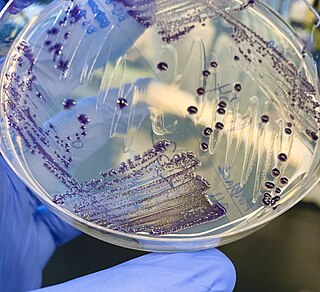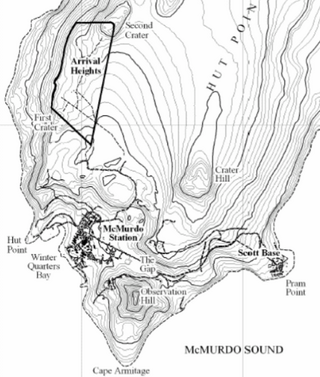
Scott Base is a New Zealand Antarctic research station at Pram Point on Ross Island near Mount Erebus in New Zealand's Ross Dependency territorial claim. It was named in honour of Captain Robert Falcon Scott, RN, leader of two British expeditions to the Ross Sea area of Antarctica. The base was set up as support to field research and the centre for research into earth sciences, and now conducts research in many fields, operated by Antarctica New Zealand.

A wood-decay or xylophagous fungus is any species of fungus that digests moist wood, causing it to rot. Some species of wood-decay fungi attack dead wood, such as brown rot, and some, such as Armillaria, are parasitic and colonize living trees. Excessive moisture above the fibre saturation point in wood is required for fungal colonization and proliferation. In nature, this process causes the breakdown of complex molecules and leads to the return of nutrients to the soil. Wood-decay fungi consume wood in various ways; for example, some attack the carbohydrates in wood, and some others decay lignin. The rate of decay of wooden materials in various climates can be estimated by empirical models.

Timothy Raymond Naish is a New Zealand glaciologist and climate scientist who has been a researcher and lecturer at Victoria University of Wellington and the Director of the Antarctic Research Centre, and in 2020 became a programme leader at the Antarctic Science Platform. Naish has researched and written about the possible effect of melting ice sheets in Antarctica on global sea levels due to high CO2 emissions causing warming in the Southern Ocean. He was instrumental in establishing and leading the Antarctica Drilling Project (ANDRILL), and a Lead Author on the Intergovernmental Panel on Climate Change (IPCC) 5th Assessment Report (2014).

Phanerochaete is a genus of crust fungi in the family Phanerochaetaceae.
In enzymology, a lignin peroxidase (EC 1.11.1.14) is an enzyme that catalyzes the chemical reaction
In enzymology, a manganese peroxidase (EC 1.11.1.13) is an enzyme that catalyzes the chemical reaction

The genus Massilia belongs to the family Oxalobacteriaceae, and describes a group of gram-negative, motile, rod-shaped cells. They may contain either peritrichous or polar flagella. This genus was first described in 1998, after the type species, Massilia timonae, was isolated from the blood of an immunocompromised patient. The genus was named after the old Greek and Roman name for the city of Marseille, France, where the organism was first isolated. The Massilia genus is a diverse group that resides in many different environments, has many heterotrophic means of gathering energy, and is commonly found in association with plants.
Many research stations in Antarctica support satellite field camps which are, in general, seasonal camps. The type of field camp can vary – some are permanent structures used during the annual Antarctic summer, whereas others are little more than tents used to support short term activities. Field camps are used for many things, from logistics to dedicated scientific research.

Arrival Heights are clifflike heights which extend in a north-east–south-west direction along the west side of Hut Point Peninsula, just north of Hut Point in Ross Island, Antarctica. They were discovered and named by the British National Antarctic Expedition, 1901–04, under Robert Falcon Scott. The name suggests the expedition's arrival at its winter headquarters at nearby Hut Point.

Lake Chapman is a small lake located on The Flatiron, at Granite Harbour within the Ross Dependency of Antarctica. It was first visited by members of Capt. Robert Falcon Scott's Western Party in 1911 and was one of the "pretty little tarns" observed by Griffith Taylor who was Senior Geologist to the expedition. Indeed, Tryggve Gran, another member of the Western Party, even used the lake for a swim to "celebrate Midsummer Day". More recently, it has been a site of active research undertaken by the University of Waikato as part of a larger terrestrial biodiversity research programme supported by the New Zealand Antarctic Research Institute (NZARI) and Antarctica New Zealand (AntNZ).
Throughout human history, fungi have been utilized as a source of food and harnessed to ferment and preserve foods and beverages. In the 20th century, humans have learned to harness fungi to protect human health, while industry has utilized fungi for large scale production of enzymes, acids, and biosurfactants. With the advent of modern nanotechnology in the 1980s, fungi have remained important by providing a greener alternative to chemically synthesized nanoparticle.
John Davidson McCraw was a New Zealand pedologist, academic, and local historian, particularly of the Central Otago area. The McCraw Glacier in Antarctica is named for him.

Michelle Rogan-Finnemore is a New Zealand-American science administrator, and currently the Executive Secretary of the Council of Managers of National Antarctic Programmes (COMNAP) which is the international association which brings together the National Antarctic Programs that make up its members. She is also the namesake of Finnemore Peak.

Gillian Shirley Wratt is a New Zealand botanist and science administrator. She was the first woman director of the New Zealand Antarctic Programme (1992–1996) and made a Member of the New Zealand Order of Merit for services to Antarctica.

Siti Aisyah Binti Haji Alias is a Malaysian marine polar researcher and lecturer. As of August 2016, she is Associate Professor and Director of the National Antarctic Research Centre (NARC) in the Malaysian Antarctic Research Programme (MARP), at the University of Malaya. Her work focuses on the physiology of marine and polar microbes and fungi.

Margaret Ann Bradshaw is a New Zealand geologist and a retired staff member at the University of Canterbury. She is considered a trailblazer and influential female role model in Antarctic research.

Margaret Ann Chapman was a limnologist, one of the first New Zealand women scientists to visit Antarctica, and the first woman to lead a scientific expedition to Antarctica. Lake Chapman, in Antarctica's Ross Dependency, was named for Chapman. Chapman spent most of her teaching career at the University of Waikato.

Phialophora fastigiata is a mitosporic, saprophytic fungus commonly found in soil, and on wood, and wood-pulp. This species was initially placed in the genus Cadophora but was later transferred to the genus Phialophora based on morphological and growth characteristics. In culture, P. fastigiata produces olive-brown, velvety colonies. The fungus is recognizable microscopically due to the presence of distinctive, funnel-shaped cuffs (collarettes) encircling the tips of phialides that bear slimy conidia. The fungus is often implicated in soft-rot wood decay due to its ability to degrade lignin, cellulose and pectin. It has also been reported to cause blue staining of wood and wood pulp.

Priscilla M. Wehi is a New Zealand ethnobiologist and conservation biologist. As at July 2021 she is an associate professor at the University of Otago and on the first of that month officially undertook the role of director of Te Pūnaha Matatini, a centre of research excellence in complex systems and data analytics. During the COVID-19 pandemic in New Zealand Te Pūnaha Matatini scientists have developed mathematical models of the spread of the virus across the country that influence the New Zealand government's response to the outbreak. In 2021 Wehi was awarded the Hill Tinsley Medal.
Megan Ruby Balks is a New Zealand Antarctic soil scientist and former lecturer of the University of Waikato.













